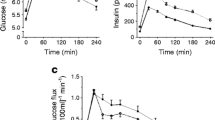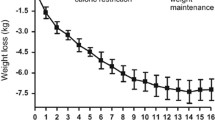Abstract
Impaired fasting glucose (IFG) and impaired glucose tolerance (IGT) are two intermediate states in the transition from normal glucose metabolism to type 2 diabetes. Insulin clamp studies have shown that subjects with IGT have increased insulin resistance in skeletal muscle, while subjects with IFG have near normal muscle insulin sensitivity. Because of the central role of altered free fatty acid (FFA) metabolism in the pathogenesis of insulin resistance, we have examined plasma free fatty acid concentration under fasting conditions, and during OGTT in subjects with IGT and IFG. Seventy-one NGT, 70 IGT and 46 IFG subjects were studied. Fasting plasma FFA in IGT subjects was significantly greater than NGT, while subjects with IFG had similar fasting plasma FFA concentration to NGT. However, fasting plasma insulin concentration was significantly increased in IFG subjects compared to NGT while subjects with IGT had near normal fasting plasma insulin levels. The adipocyte insulin resistance index (product of fasting plasma FFA and FPI) was significantly increased in both IFG and IGT subjects compared to NGT. During the OGTT both IFG and IGT subjects suppressed their plasma FFA concentration similarly to NGT subjects, but the post-glucose loads were significantly increased in both IFG and IGT subjects. These data suggest that both subjects with IFG and IGT have increased resistance to the antilipolytic action of insulin. However, under basal conditions, fasting hyperinsulinemia in IFG subjects is sufficient to offset the adipocyte insulin resistance and maintain normal fasting plasma FFA concentration while the lack of increase in FPI in IGT subjects results in an elevated fasting plasma FFA.


Similar content being viewed by others
References
DeFronzo RA (2004) Pathogenesis of type 2 diabetes mellitus. Med Clin North Am 8:787–835
Bays H, Mandarino L, DeFronzo RA (2004) Role of the adipocyte, free fatty acids, and ectopic fat in pathogenesis of type 2 diabetes mellitus: peroxisomal proliferator-activated receptor agonists provide a rational therapeutic approach. J Clin Endocrinol Metab 89:463–478
Schalch DS, Kipnis DM (1965) Abnormalities in carbohydrate tolerance associated with elevated plasma nonesterified fatty acids. J Clin Invest 44:2010–2020
Reaven GM (1995) The fourth musketeer—from Alexandre Dumas to Claude Bernard. Diabetologia 38:3–13
Belfort R, Mandarino L, Kashyap S, Wirfel K, Pratipanawatr T, Berria R, Defronzo RA, Cusi K (2005) Dose-response effect of elevated plasma free fatty acid on insulin signaling. Diabetes 54:1640–1648
Bajaj M, Suraamornkul S, Romanelli A, Cline GW, Mandarino LJ, Shulman GI, DeFronzo RA (2005) Effect of a sustained reduction in plasma free fatty acid concentration on intramuscular long-chain fatty acyl-CoAs and insulin action in type 2 diabetic patients. Diabetes 54:3148–3153
Unwin N, Shaw J, Zimmet P, Alberti KGMM (2002) Impaired glucose tolerance and impaired fasting glycemia: the current status on definition and intervention. Diabet Med 19:708–723
Abdul-Ghani MA, Tripathy D, DeFronzo RA (2006) Contributions of beta cell dysfunction and insulin resistance to the pathogenesis of impaired glucose tolerance and impaired fasting glucose. Diabetes Care 29:1130–1139
Abdul-Ghani MA, Tripathy D, Jenckinson C, Ritchardson D, DeFronzo RA (2006) Insulin secretion and insulin action in subjects with impaired fasting glucose and impaired glucose tolerance: results from the Veterans Administration Genetic Epidemiology Study (VEGAS). Diabetes 55:1430–1435
The Expert Committee on the Diagnosis and Classification of Diabetes Mellitus (1997) Report of the expert committee on the diagnosis and classification of diabetes mellitus. Diabetes Care 20:1183–1197
Groop LC, Bonadonna RC, Del Prato S, Ratheiser K, Zyck K, Ferrannini E, DeFronzo RA (1989) Glucose and free fatty acid metabolism in non-insulin-dependent diabetes mellitus. Evidence for multiple sites of insulin resistance. J Clin Invest 84:205–213
DeFronzo RA (1997) Insulin resistance: a multifaceted syndrome responsible for NIDDM, obesity, hypertension, dyslipidaemia and atherosclerosis. Neth J Med 50:191–197
Bonadonna RC, Groop LC, Zych K, Shank M, DeFronzo RA (1990) Dose-dependent effect of insulin on plasma free fatty acid turnover and oxidation in humans. Am J Physiol 259:E736–E750
Weyer C, Bogardus C, Pratley RE (1999) Metabolic characteristics of individuals with impaired fasting glucose and/or impaired glucose tolerance. Diabetes 48:2197–2203
Wasada T, Kuroki H, Katsumori K, Arii H, Sato A, Aoki K, Jimba S, Hanai G (2004) Who are more insulin resistant, people with IFG or people with IGT? Diabetologia 47:758–759
Robinson C, Tamborlane WV, Maggs DG, Enoksson S, Sherwin RS, Silver D, Shulman GI, Caprio S (1998) Effect of insulin on glycerol production in obese adolescents. Am J Physiol 274:E737–E743
Campbell PJ, Carlson MG, Nurjhan N (1994) Fat metabolism in human obesity. Am J Physiol 266:E600–E605
Author information
Authors and Affiliations
Corresponding author
Rights and permissions
About this article
Cite this article
Abdul-Ghani, M.A., Molina-Carrion, M., Jani, R. et al. Adipocytes in subjects with impaired fasting glucose and impaired glucose tolerance are resistant to the anti-lipolytic effect of insulin. Acta Diabetol 45, 147–150 (2008). https://doi.org/10.1007/s00592-008-0033-z
Received:
Accepted:
Published:
Issue Date:
DOI: https://doi.org/10.1007/s00592-008-0033-z




